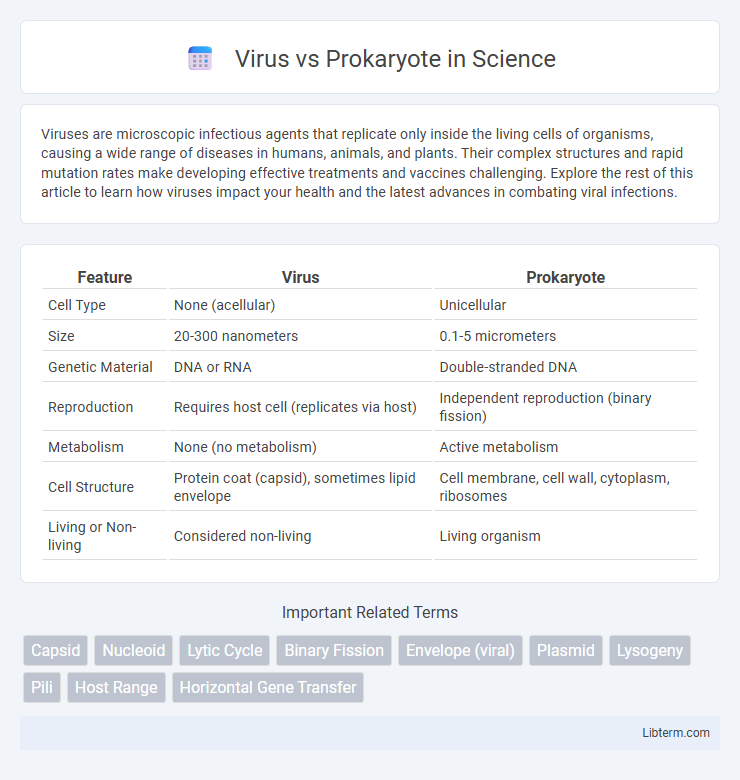Viruses are microscopic infectious agents that replicate only inside the living cells of organisms, causing a wide range of diseases in humans, animals, and plants. Their complex structures and rapid mutation rates make developing effective treatments and vaccines challenging. Explore the rest of this article to learn how viruses impact your health and the latest advances in combating viral infections.
Table of Comparison
| Feature | Virus | Prokaryote |
|---|---|---|
| Cell Type | None (acellular) | Unicellular |
| Size | 20-300 nanometers | 0.1-5 micrometers |
| Genetic Material | DNA or RNA | Double-stranded DNA |
| Reproduction | Requires host cell (replicates via host) | Independent reproduction (binary fission) |
| Metabolism | None (no metabolism) | Active metabolism |
| Cell Structure | Protein coat (capsid), sometimes lipid envelope | Cell membrane, cell wall, cytoplasm, ribosomes |
| Living or Non-living | Considered non-living | Living organism |
Introduction to Viruses and Prokaryotes
Viruses are microscopic infectious agents composed of genetic material, either DNA or RNA, enclosed in a protein coat called a capsid, lacking cellular structure and metabolic processes. Prokaryotes, including bacteria and archaea, are unicellular organisms characterized by the absence of a nucleus and membrane-bound organelles, with genetic material freely located in the cytoplasm. While viruses require a host cell to replicate, prokaryotes can reproduce independently through binary fission and perform essential metabolic activities.
Defining Characteristics of Viruses
Viruses are acellular entities composed of a protein coat called a capsid encasing genetic material, either DNA or RNA, but lack cellular structures such as a nucleus or organelles. Unlike prokaryotes, viruses cannot carry out metabolic processes or reproduce independently, requiring a host cell to replicate. Their defining characteristics include obligate intracellular parasitism, specificity to host cells, and ability to hijack host machinery for viral genome replication and protein synthesis.
Key Features of Prokaryotes
Prokaryotes are unicellular organisms characterized by the absence of a nucleus and membrane-bound organelles, with genetic material located in a nucleoid region. They possess a rigid cell wall composed mainly of peptidoglycan, allowing structural support and protection. Prokaryotes reproduce asexually through binary fission and exhibit diverse metabolic pathways, enabling survival in various environments.
Structural Differences: Virus vs Prokaryote
Viruses consist of a protein coat called a capsid enclosing genetic material, either DNA or RNA, and lack cellular structures such as cytoplasm, ribosomes, and membranes found in prokaryotes. Prokaryotes, including bacteria and archaea, have a plasma membrane, cell wall, cytoplasm, ribosomes, and typically a circular DNA chromosome, enabling independent reproduction and metabolism. Unlike viruses, which require host cells for replication, prokaryotes can carry out all necessary life processes autonomously.
Reproduction and Replication Mechanisms
Viruses replicate by hijacking a host cell's machinery to produce viral components, assembling new virions without independent metabolic processes. Prokaryotes reproduce independently through binary fission, a process of DNA replication followed by cell division, enabling rapid population growth. Unlike viruses, prokaryotes possess the cellular structures and enzymes necessary for autonomous replication and metabolism.
Genetic Material: Comparison and Diversity
Viruses contain either DNA or RNA as their genetic material, which can be single-stranded or double-stranded, allowing for diverse replication strategies and rapid mutation rates. Prokaryotes possess circular double-stranded DNA chromosomes along with plasmids, providing genetic stability and opportunities for horizontal gene transfer. The genetic diversity in viruses arises from high mutation and recombination rates, whereas prokaryotic diversity is enhanced by gene transfer mechanisms such as conjugation, transformation, and transduction.
Metabolic Capabilities and Limitations
Viruses lack metabolic capabilities entirely, relying completely on host cells for energy production and biosynthesis, as they do not possess the cellular machinery required for metabolism. Prokaryotes, including bacteria and archaea, have fully functional metabolic systems capable of processes such as glycolysis, respiration, and photosynthesis, enabling autonomous energy generation and nutrient assimilation. The absence of metabolic pathways in viruses highlights their dependence on host organisms, contrasting sharply with the self-sufficient metabolic versatility seen in prokaryotes.
Interactions with Hosts
Viruses depend on host cells for replication, injecting their genetic material to hijack the cell's machinery and produce viral progeny, often causing cellular damage or death. Prokaryotes engage in complex interactions with hosts, ranging from mutualistic relationships that benefit both parties to pathogenic infections that trigger immune responses. Understanding the molecular mechanisms of viral entry and prokaryotic colonization is essential for developing treatments against infectious diseases.
Roles in Disease and Medicine
Viruses cause a wide range of diseases by invading host cells and hijacking their machinery to replicate, leading to illnesses like influenza, HIV/AIDS, and COVID-19, while prokaryotes, including bacteria, can be both pathogens causing infections such as tuberculosis and beneficial microbes used in probiotics and antibiotic production. Viruses lack cellular structure and metabolism, making antiviral drug development challenging, whereas prokaryotes serve as targets for antibiotics and sources for novel antibiotics that combat bacterial resistance. Understanding viral replication and bacterial physiology is crucial for developing vaccines, antimicrobial therapies, and biotechnological applications in medicine.
Evolutionary Insights and Relationships
Viruses and prokaryotes exhibit distinct evolutionary pathways, with viruses likely originating from genetic elements that escaped cellular organisms. Prokaryotes, comprising bacteria and archaea, have ancient lineages tracing back over 3.5 billion years, showcasing complex evolutionary adaptations like horizontal gene transfer. Understanding virus-prokaryote interactions, such as bacteriophage-mediated gene exchange, unveils critical insights into microbial evolution and co-evolutionary dynamics shaping genetic diversity.
Virus Infographic

 libterm.com
libterm.com